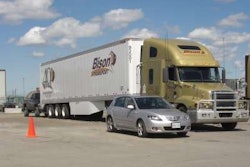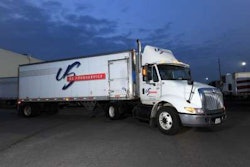Long before dawn this morning, when professional driver Marty Peters pulled on his brown uniform for the last time and headed for his final day on the job at UPS, it marked the end of a remarkable career.
Peters, who turned 87 on Aug. 10, is the longest-tenured employee in the company’s history, retiring with 63 years, five months and 29 days of service. He’s retiring on UPS Founder’s Day — today, Aug. 28, the company’s 102nd anniversary — and has seen much of the company’s history firsthand.
“Marty Peters is the quintessential dedicated UPS employee,” says Scott Davis, chairman and chief executive officer of Atlanta-based UPS. “This is a man who went the extra mile, and kept right on going. We sincerely thank him for his many years of service and congratulate him on this incredible achievement.”
When Peters started work at UPS in March 1946, the first Baby Boomers were still in diapers. And now, in an age when the average job tenure in the United States is barely four years, employees like Peters are rare indeed.
“I’ve treated every package as if it were my own,” said Peters, who joined UPS straight from service in the U.S. Army and World War II. Competition was fierce then for delivery jobs that paid 95 cents an hour. “There must have been about 10,000 of us coming out of the Army and trying to get a job. That was a lot of money.”
During the 1940s, Peters braved frigid Michigan winters in an air-cooled White Horse delivery truck without a heater or a defroster. After that, he held a variety of jobs from sorting packages and loading trucks to logging more than 1.4 million miles driving a tractor-trailer on a route between Detroit and Grand Rapids.
A resident of Macomb Township, Mich., Peters for many years has worked a 3:30 a.m. to 12:30 p.m. shift at UPS’s Woodbridge Center in Detroit as a “shifter” and a clerk. He spends most of his time behind the wheel of a tractor truck, moving 50 to 70 trailers each day between loading docks at the center. Later, Peters moves inside to help incorrectly addressed packages reach their intended destinations.
Peters has seen a lot of changes in the way UPS drivers do their jobs; chief among them was the introduction of the Delivery Information Acquisition Device, or DIAD, the small handheld computer that replaced the pen and paper used by drivers to record pickups and deliveries. An earlier technological change that had a major impact on Peters? The ballpoint pen, which he said eliminated the need to carry a pocketknife for sharpening pencils.
Peters and his wife, Christine, have been married since 1950 and have four children, nine grandchildren and two great-grandchildren.













